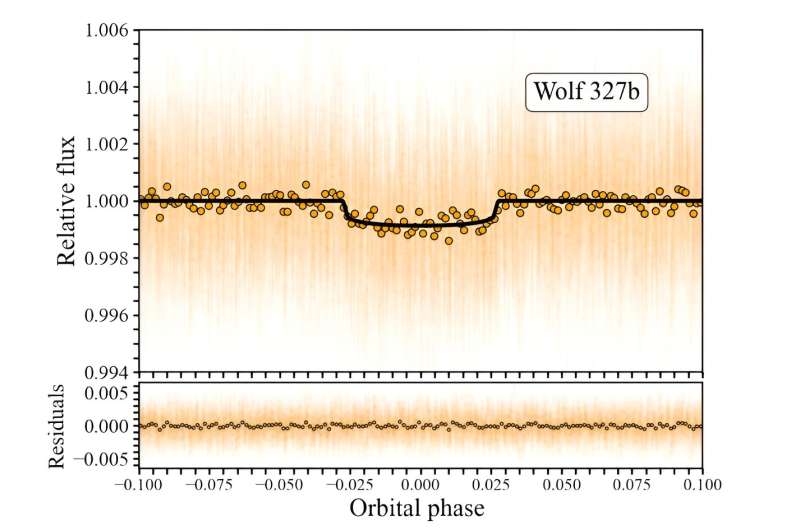January 30, 2024 report
This article has been reviewed according to Science X's editorial process and policies. Editors have highlighted the following attributes while ensuring the content's credibility:
fact-checked
preprint
trusted source
proofread
New Wolf in the pack: Astronomers discover an ultra-short-period super-Earth

Using NASA's Transiting Exoplanet Survey Satellite (TESS), an international team of astronomers has discovered a new ultra-short-period exoplanet. The newfound alien world, designated Wolf 327 b, is slightly larger and about 2.5 times more massive than the Earth. The finding was reported in a paper published January 22 on the pre-print server arXiv.
To date, TESS has identified over 7,000 candidate exoplanets (TESS Objects of Interest, or TOI), of which 415 have been confirmed so far. Since its launch in April 2018, the spacecraft has been conducting a survey of about 200,000 of the brightest stars near the sun with the aim of searching for transiting exoplanets—ranging from small, rocky worlds to gaseous giants.
A group of astronomers led by Felipe Murgas of the University of La Laguna, Spain, now reports the confirmation of another TOI monitored by TESS. According to the recently published study, a transit signal has been identified in the light curve of Wolf 327—a nearby M-dwarf star. The planetary nature of this signal was confirmed by follow-up photometry, high resolution imaging, and radial velocity (RV) measurements.
"The detection of the transit events was led by NASA's TESS mission, and ground-based observations confirmed that the transit events occur on the star Wolf 327. Follow-up RV measurements taken with the CARMENES spectrograph allowed us to establish the mass of the candidate and confirm its planetary nature," the researchers wrote.
Wolf 327 b has a radius of 1.24 Earth radii and its mass was measured to be 2.53 Earth masses, which yields a bulk density at a level of 7.24 g/cm3. The planet orbits its parent star every 13.7 hours at a distance of about 0.01 AU from it, and its equilibrium temperature is estimated to be almost 1,000 K. Therefore, Wolf 327 b was classified by Murgas' team as an ultra-short-period (USP) super-Earth.
The results suggest that Wolf 327 b is a rocky planet with a Mercury-like internal composition. The astronomers assume that this exoplanet has a substantial iron core surrounded by a small mantle layer, and possesses a negligible hydrogen/helium atmosphere.
When it comes to Wolf 327, it is a 4.1-billion-year-old M dwarf of spectral type M2.5 V, located some 93 light years away. The star is only 40% the size and mass of the sun, has an effective temperature of 3,542 K, and a metallicity estimated to be approximately -0.17 dex.
Summing up the results, the authors of the paper say this is an interesting addition to the known sample of USP planets orbiting M-dwarf stars, due to its interesting internal structure and favorable metrics for secondary transit detection with the James Webb Space Telescope (JWST). According to the authors, there is also a high probability that other planets also orbit Wolf 327, given that USPs are usually found in multi-planetary systems.
More information: F. Murgas et al, Wolf 327b: A new member of the pack of ultra-short-period super-Earths around M dwarfs, arXiv (2024). DOI: 10.48550/arxiv.2401.12150
Journal information: arXiv
© 2024 Science X Network





















